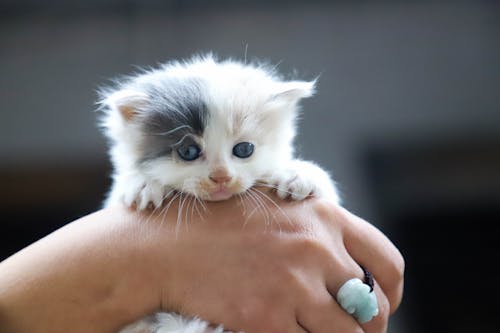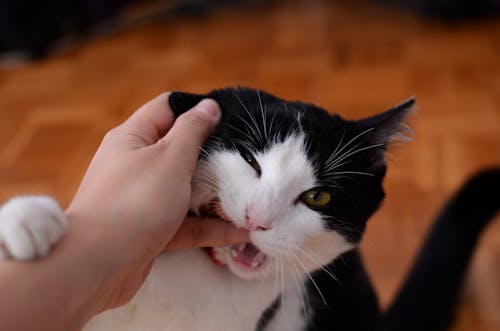
Training a cat to stop scratching people can be challenging, especially when the behavior is ingrained or instinctive. Cats often use their claws as part of their natural play, defense, or communication habits. However, it's important for cat owners to establish boundaries and teach their cats to avoid harmful behavior, such as extending their claws during play or interaction.
One of the most effective ways to address this behavior is to create a negative association with claw extension toward humans. Every time your cat extends its claws, make sure to communicate displeasure immediately. You can use a stern voice and even lightly tap your cat's rear with a rolled-up newspaper to let it know that this behavior is unacceptable. The key is to act quickly so that the cat can associate its scratching behavior with a negative consequence. If the cat tries to extend its claws again after this correction, repeat the process. Over time, the cat will start to understand that extending its claws during interactions is not tolerated.
It's also essential to redirect your cat's natural urge to scratch by providing it with appropriate outlets. Cats love to play, and during these playful moments, they often engage in scratching or pouncing behaviors. One way to redirect this energy is by giving your cat plenty of toys. For example, toy mice or feathered wands are excellent distractions that can fulfill the cat’s play drive without involving human hands. When your cat engages with the toys, offer positive reinforcement by praising or rewarding it with treats. This encourages the cat to understand that it can release its energy through toys rather than by scratching humans.

Some cats may be in a teething phase, especially when they are young. During this period, they may be more prone to scratching and biting because their gums are sore. In such cases, avoid provoking or teasing the cat with your hands, as this could lead to scratching. Instead, provide your cat with items like chew toys or scratching posts that can help alleviate their teething discomfort. You can also wrap furniture legs in sisal or other durable materials to prevent your cat from damaging household items while satisfying its natural need to scratch and bite.
It’s not uncommon for cat owners to encounter situations where their seemingly calm cat suddenly extends its claws during play. You may be playing with your cat one moment, and the next, you’re left with scratch marks on your hands or arms. Often, these playful scratches occur because the cat is overstimulated or doesn’t yet fully understand the limits of play with humans. This kind of behavior, known as play aggression, can sometimes be unintentionally encouraged by the way people interact with their cats. For example, if you frequently use your hands or feet to play with your cat, it may learn to view these body parts as toys. This is especially true for cats that were weaned early or hand-raised by humans, as they may not have had the chance to learn proper play behavior from their littermates.
If your cat has already developed a habit of play aggression, it’s important to avoid using your hands or feet as toys. Instead, always use actual toys during playtime. When your cat pounces on your hands or feet instead of the toy, immediately stop all movement and disengage from the interaction. Walk away if necessary. By doing this, you’re teaching your cat that playtime ends when it scratches or bites. Only resume play when the cat has calmed down and is no longer using its claws inappropriately.
In addition to proper play behavior, it's vital to ensure that your cat gets enough physical and mental stimulation. Boredom can sometimes lead to increased scratching and other undesirable behaviors. Installing a cat tree, playing with interactive toys, or even introducing puzzle feeders can help keep your cat engaged and reduce its desire to scratch humans. A tired cat is far less likely to exhibit aggressive behaviors.
Regularly trimming your cat’s claws can also reduce the potential for injury. Cats’ claws grow continuously, and they instinctively sharpen them through scratching. By trimming their nails, you reduce the sharpness of their claws, which can make any accidental scratching less painful. It's a simple and humane solution that doesn't interfere with their natural instincts. Clipping their claws won’t harm your cat and can help mitigate the damage they do when they do use their claws.
By using consistent, clear communication and providing appropriate outlets for your cat’s natural behaviors, it’s possible to teach them to stop extending their claws during interactions. With patience and the right approach, your cat will learn to play and interact without resorting to scratching.

Another critical aspect of preventing unwanted scratching behavior is understanding your cat's body language. Cats often give subtle signs before they escalate to using their claws or teeth. These signs can include dilated pupils, twitching tails, flattened ears, or sudden stillness. By learning to recognize these signals, you can intervene before the scratching begins. For instance, if you notice your cat becoming overstimulated during play, it's a good idea to pause and give the cat a break. Cats sometimes become overwhelmed, and giving them time to calm down can prevent scratches and bites.
In some cases, cats extend their claws as a way of seeking attention or as a reaction to stress. If your cat starts to scratch you suddenly or out of nowhere, take a step back and evaluate the environment. Has something in your cat’s daily routine changed recently? Cats are creatures of habit, and even small disruptions—such as moving furniture, introducing a new pet, or a change in feeding times—can cause them to feel stressed. Stress can manifest in behaviors like scratching, biting, or excessive grooming. Ensuring your cat has a consistent, stress-free environment can go a long way in reducing aggressive behaviors.
Providing your cat with designated scratching areas is another effective way to redirect its need to scratch. Cats naturally have an instinct to scratch for various reasons: to mark territory, to stretch, and to maintain the health of their claws. Giving your cat scratching posts, mats, or pads throughout your home can satisfy these needs without resorting to scratching people or furniture. Make sure these scratching areas are placed in convenient locations—near where the cat likes to rest or play—so it’s easy for your cat to use them. Some owners even use catnip or other attractants to encourage their cats to engage with the scratching posts rather than human hands.
Positive reinforcement plays a significant role in shaping your cat's behavior. When your cat uses the scratching post instead of your furniture or your body, reward it with treats or praise. Reinforcing this good behavior helps your cat understand where it's appropriate to use its claws and where it’s not. Over time, your cat will start to prefer the scratching post because it associates it with positive experiences.
On the flip side, when your cat scratches you, it’s important not to unintentionally reinforce the behavior. For example, if you yell or dramatically react when your cat scratches you, it might view this as attention—even if it's negative attention. Some cats will continue the behavior because they enjoy the reaction they get. Instead, when your cat scratches, try to remain calm, disengage from the interaction, and redirect its attention to a toy or scratching post.
For persistent scratchers, there are also additional deterrents that can be used to protect both your skin and your belongings. Soft nail caps, for example, can be applied to a cat’s claws to minimize the damage done during scratching. These caps are harmless and will eventually fall off as the cat’s nails grow, but they can provide a temporary solution for cats that are still learning not to scratch. Another option is using double-sided tape or specially designed sprays on furniture to make surfaces less appealing for scratching.
Ultimately, consistency is the key to success when training your cat not to scratch. If everyone in your household responds to the scratching in the same way, your cat will learn faster. Mixed messages, like allowing the cat to scratch at some times and not others, can confuse the cat and slow down the training process. Make sure everyone involved in the cat’s care knows the rules and follows the same training methods.
In conclusion, teaching a cat not to scratch people requires patience, consistency, and understanding of the cat’s natural instincts. By using a combination of negative reinforcement, positive reinforcement, and appropriate outlets like toys and scratching posts, you can train your cat to engage in safe and appropriate behaviors. With time and effort, you’ll not only protect yourself and your belongings from scratches but also create a more harmonious and enjoyable relationship with your feline friend.
